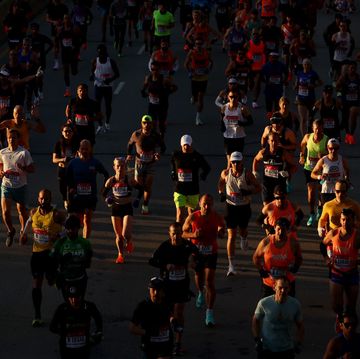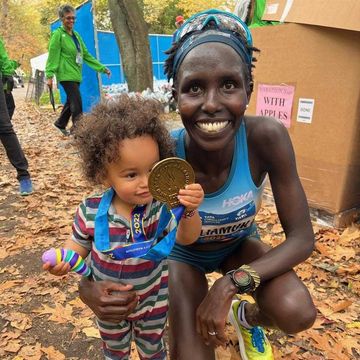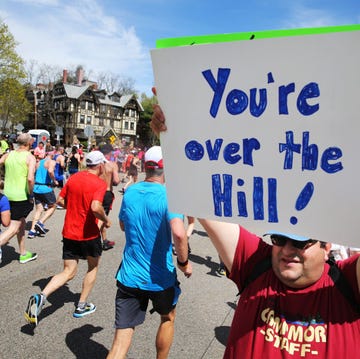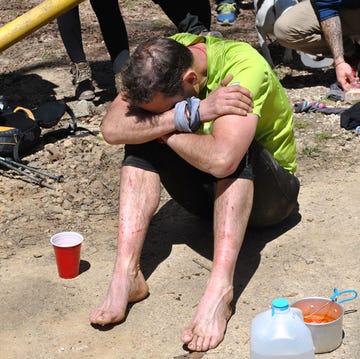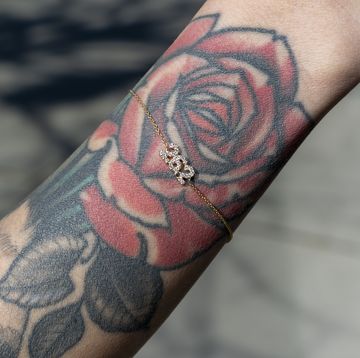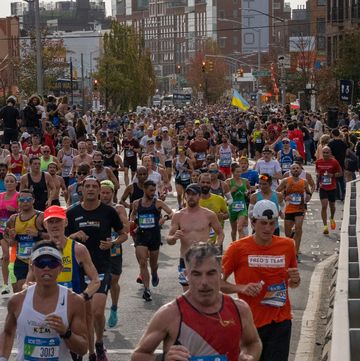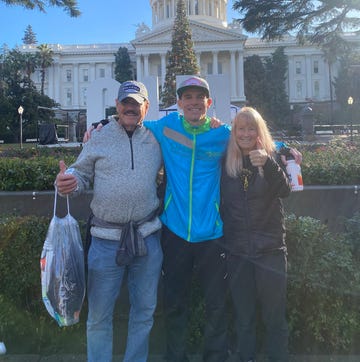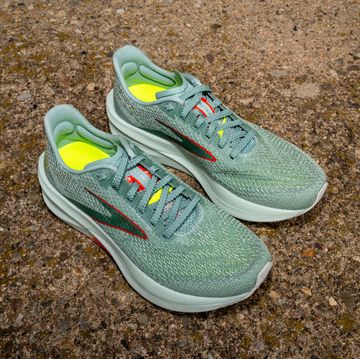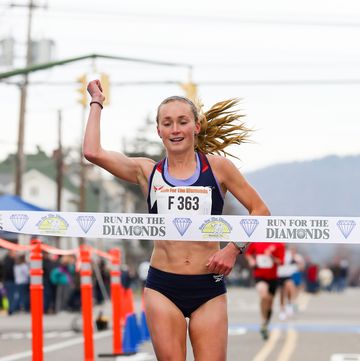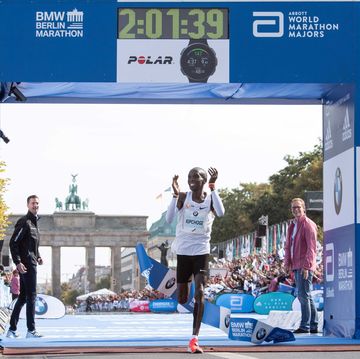The Shoe Des Wore to Break the 50K World Record
It all started when 17 men lined up on a dusty road in the village of Marathon, 25 miles from Athens, Greece. Behind them their attendants perched on laden bicycles, and a cluster of horses bearing officials stamped and snorted. The starter made a speech about national pride and fired his pistol. At that moment began one of the greatest series of sports events the world has known -- the Olympic marathon.
There has never been a dull race among the 25, so I can only offer apologies for omitting such champions as Hannes Kolehmainen (Finland, 1920), Boughera El Ouafi (1928, the first African champion, though he represented France), Sohn Kee-Chung (1936, Korean, representing Japan), Delfo Cabrera (Argentina, 1948), Emil Zatopek (Czechoslovakia, 1952), or Stefano Baldini (Italy, 2004). But the five races I have chosen have attained the senior resonance of myth.
5. ATHENS, 1896
When that pistol fired in the village of Marathon, it was predictably three foreign track runners who raced ahead. By 10 miles, Albin Lermusiaux (France), prancing along with neat white gloves and Gallic verve, had a huge lead. At halfway, where the hills began, the villagers of Harvati cheered him through a triumphal arch and crowned him with leaves. But the Frenchman was wilting. He was replaced as leader by the jaunty Australian Teddy Flack, the 800m and 1500m champion, roguishly sporting a tasseled school cap and escorted by a bicycling butler in a bowler hat. But style counts for little in the Olympic marathon. Way behind, a humble Greek peasant called Spiridon Louis, a water-carrier by trade, took a glass of wine at a taverna in Pikermi, and announced quietly that he would win. He was used to pacing himself on these dusty hills. Trotting steadily with teammate Kharilaos Vasilakos, he delayed his move until 21 miles, then closed on Flack so quickly that the Australian folded. Now the crowds through the outskirts of Athens shouted "Ellene! Ellene!" ("Greek! Greek!"). Boys whooped alongside and girls scattered flower petals under Louis' feet. The stadium crowd (estimated at up to 125,000) "went mad for joy" as the little figure in white entered. Two royal princes ran alongside him, flourishing their hats. Vasilakos was second, seven minutes behind. For Louis, it was a moment that made him a hero, a legend, and a proverb. For Greece, it was national ecstasy. For the Olympic marathon, it was a triumphant birth.
4. has been acclaimed as one of the best ever published. Roger was a senior writer for
This was the most enthralling kind of race, a big group of talented equals sharing the work, pressing, waiting, watching for the first sign that the heat and the unremitting speed had drained some rival's strength. After halfway, one by one they drifted back, even godlike favorites like Rod Dixon (New Zealand), Rob de Castella (Australia), Toshihiko Seko (Japan), and Juma Ikangaa (Tanzania). By 22 miles there were four survivors: Charlie Spedding (Britain) and Carlos Lopes (Portugal), an inch in front of John Treacy (Ireland) and Joe Nzau (Kenya). Soon you could see that it was the 37-year-old Lopes, self-contained and inwardly focused, who was in charge. Imperceptibly, insidiously, from mile to mile, he was accelerating. His rivals struggled at each shift of the gears. He cut a drink station, and Nzau was gone. Almost in sight of the stadium, Lopes gave one more turn of the screw, and opened the first gap in 24 miles of hard running. On TV you could see into his deep-set eyes, seemingly oblivious to the flag-flapping frenzy of the Los Angeles sidewalks. Under the shadow of the Coliseum wall, he looked back for the first time. He was alone. Treacy was agonizingly edging away from Spedding, in their remorseless struggle against each other and sheer fatigue. But this race belonged to Lopes, a man, like Spiridon Louis, of rural origins. He circled the acclaiming stadium and took the Olympic record (2:09:21) with not a touch of showmanship. For some great marathon runners, the joy and the pride are all on the inside.
3. MUNICH, 1972
It was a phenomenal field, at that moment in history when the world's greatest distance runners first grasped at the Olympic marathon as the ultimate prize. A postponement by one day because of the massacre of Israeli athletes disrupted the preparation of some favorites, but the race rose above such factors. The lead pack was a Who's Who of that vintage era: defending Olympic champion Mamo Wolde (Ethiopia), European champion Ron Hill (Britain), world-record holder Derek Clayton (Australia), cross country maestro Gaston Roelants (Belgium), Jack Foster (New Zealand), Karel Lismont (Belgium), the Japanese, the Finns, the Ethiopians, and three runners from an emerging marathon nation, the United States -- Jack Bacheler, Kenny Moore, and Frank Shorter. With 31:15 at 10K, the pace was fast. And then Shorter made it faster. Silky-smooth, he ran sub-15 minutes for the next 5K. Nothing in the magical lightness of his moving showed the effort of such a pace, but the evidence was the five-second gap to Lismont, Foster and Wolde, and the struggling stars behind them. Clayton, Hill and Roelants were off the back. The ancient Greek poets would have loved Shorter that day. "He seemed on feathered feet to fly," one wrote. Not even the tortuous gravel paths through the English Garden back to the stadium disturbed his springy poise. Shorter won by more than two minutes (2:12:11), over Lismont, Wolde, and Moore, setting off the first American running boom in the process.
2. ROME, 1960
From the Capitoline Hill to the Arch of Constantine, this was the only Olympic marathon wholly away from the stadium, and the only one run into the evening and deepening darkness. Italians know how to stage a drama. The early race looked a tactical battle between the fast-starters, Arthur Keily (Britain) and Aurele Vandendriessche (Belgium), and the more calculating world-record holder, Sergey Popov (USSR) and his steely teammate Konstantin Vorobiev. But two unexpected figures closely trailed the leaders, Abdesselem ben Rhadi, a Moroccan known for cross country prowess in France's colors, and the totally unrecognized, pick-thin Abebe Bikila (Ethiopia), who, astonishingly, was running barefoot. In the humid twilight, after nearly an hour of running, these two stepped around the Europeans and began a surge (14:37 from 15K to 20K) that broke the field. Never before had two Africans led an Olympic distance race. The rest was a long duel between the composed Bikila and the angular, effortful Rhadi. Behind them, New Zealand's Lydiard-coached Barry Magee passed the two Soviets for third. Bikila and Rhadi raced back into old Rome. Only in the last mile, on the Appian Way, entrance of emperors to the ancient city, did Bikila begin to flow ahead. Calm and dignified, even at that level of stress, he ran smoothly through the dank darkness, in and out of patches of flickering light from flares held on long poles by Italian soldiers. He passed beneath the great stone Arch of Constantine 25 seconds in the clear, in a world record of 2:15:16.2. This race had the gladiatorial battle with Rhadi, the antique aura of the city, and the unforgettable image of a new force of history emerging out of darkness to run through the archway of conquerors. Rome's streets had seen no worthier passing of great warriors.
1. LONDON, 1908
They started outside Windsor Castle, with the royal family picnicking on the lawn, 26 miles 385 yards from the finish line in White City Stadium. If you ever find a marathon one mile too far, blame British royalty. Perhaps inspired by the presence of the Princess of Wales, a big group of British runners went out fast, news that delighted the huge crowd waiting in the stadium. But it was too fast, given 1908 training and the day's hot sun. Two survived to 10 miles, but 56:53 was still suicidal. Soon it was the big South African Charles Hefferon in front, shaking off the little Italian Dorando Pietri. Behind, the pre-race favorite, Canadian Indian Tom Longboat, attacked hard, raced through to second at 16 miles, but by 17 was walking. To quench his thirst he was given champagne by his bicycle attendant, which probably did not help. Hefferon led by two minutes at 15 miles, by nearly four at 20 miles. The race was surely his. But those days no one understood how suddenly the tank can go dry in a marathon. Pietri caught Hefferon at 25. Now began the drama that entered the consciousness of the 20th century. Pietri was heat-exhausted. He collapsed, unseen by the crowd, in the passage into the stadium. Then he entered, to the roar of 100,000 spectators. But he was shuffling, staggering, and confused. Officials had to turn him the right way for the final half circuit of the big (three laps to the mile) track. He floundered a few steps, then crumpled. Officials and medical attendants ran to help. "It was impossible to leave him there, for it looked as if he might die," said the official report later. Lifted to his feet, he covered a few more yards, and fell again. The crowd demanded that he be helped. Twice more he was rubbed and raised, twice more he stuttered a few yards and collapsed. "Surely he is done now," wrote Sir Arthur Conan Doyle, observing from the stand. Now the next runner appeared, Johnny Hayes of the United States, who had judged the distance perfectly, and (I have calculated) was moving at close to 6-minute miles at the end. As Hayes reached the final bend, Pietri was on his feet once more, and with floppy legs and dazed face, supported at the right elbow by race manager Jack Andrew, he tottered to the tape. Thus was created one of the iconic sports images of all time. Pietri was hastily declared the winner, there was a protest, Hayes properly replaced him, controversy raged, and the marathon footrace entered the world's imagination as the ultimate challenge to human endurance.
More From Runner's World

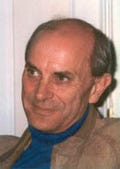
Roger Robinson is a highly-regarded writer and historian and author of seven books on running. His recent Best Walking Shoes Legendary battles and heroes Running Times and is a frequent Runner’s World contributor, admired for his insightful obituaries. A lifetime elite runner, he represented England and New Zealand at the world level, set age-group marathon records in Boston and New York, and now runs top 80-plus times on two knee replacements. He is Emeritus Professor of English at Victoria University of Wellington, New Zealand, and is married to women’s running pioneer Kathrine Switzer.
